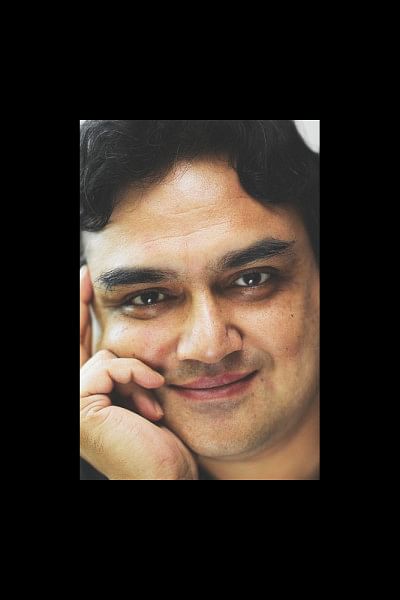DISTILLED, DELICATE, DEFINITIVE: SUDEEP SEN'S OEUVRE

Fractals is an encounter with a design paradigm, a certain matryoshka revelation of dolls-within-dolls. The book is tastefully divided into three sections: 'New Poems', 'Selected Earlier Poems' and 'Selected Translations' that are further subdivided in multiple sections — each title heightening the iteration, stylishly corralling into 'The Droste Effect'.
I like big books and I cannot lie. Consider this: 384 pages, over 300 poems, a Randall Jarell poet struck by lightning five or six times or maybe more, torrential Bela Tarr rain and Glenfiddich on the rocks — Fractals is all this and more, exponentially more.
Reading Sudeep Sen's Fractals is like entering a recursive rabbit hole of rain and petrichor in a world replete with gouache shades and madness — the Matisse cut-out variety. It is an exploration of his virtuosity, a curious blend of language, rhythm, syntax, salmon and the smoky flavour of 'Single Malt'. Or just savour the Zen-like clarity and quietude in the poem, 'Silence':
Silence has its own
subtle colour.
Between each breath
pause, heat simmers
latent saliva —
tongue-entwined lisp.
Here and there,
errant clouds wait,
yearning for rain.
Desire melting
even silence to words —
word's colour bleed
incarnadine, as your lips
whisper softly
the secrets of your silence.
Your fine chikan blouse —
white, sheer,
and almost transparent —
cannot hide the quiet
of your heart-beat
on your wheat-olive skin.
The milk-white flower
adorning your hair,
sheds a solitary petal,
just one. In that petal
silence blooms colour —
white, transparent white —
pure white silence.
One of the first things that strikes you is the luminosity of the book, and I am not talking about the grass & vanilla mustiness but an antiquarian eye for detail. Let me go all Susan Sontag on you. I suddenly see everything in quotation marks. 'Cut-and-paste'. Sample the poem 'Blue Nude II', a sonnet quoted below in full, where Sudeep deftly weaves in Matisse's technique of 'painting with scissors':
Gently she has shifted her alloted space
this time, and with it
the supine arch of her grace,
the soft-posture tempering her inter-locking
limbs and body, the sun, and the art
itself. But this sun's apogee
has disappeared, unlighting the parts
previously lit by passion's heat.
It's burnt ends, now slowly gathering
pace. Up-close, she looks flushed when kissed,
but from afar, her changing
mood is too subtle and hardly noticed.
The cut-and-paste may alter its clarity,
but never her skin's bare purity.
In a beautifully spare poem like, 'Climax', both erotica and the couched metaphor of film-history/theory (in this case, Orson Welles's Citizen Kane) is alluded to at the same time with understated subtlety:
Lips of a rose-
bud open,
to let, the dew
drop in.
If Fractals is indeed a woman, then, how should we read her? Let us look at her with an aesthete's eye — the architecture, the art of the lapidary typography and structure. Flaubert said that poetry is as exact a science as geometry. Sudeep bisects his poem 'Suspended Particles' in two equal parts on the page, each word airborne like dust.
Two shafts A lost bee
of sunlight drones in
bisect through
this room — the window
His prose poem 'Odissi' combines the laterite felicity of temple art with sculptural finesse. Words are impeccably laid in ashlar masonry where "petals, incense, anklets" fuse together and emerge as one body:
Architectural love and body
love are one for me.
Stone and flesh are one.
The poem 'Dali's Pâte de Verre' is significant, not only because it brings innovative glassmaking and the Art Nouveau movement to life in words, or its reference to Freud, or the angst of the subconscious — I love it because each stanza reminds me of about the enigma of a photograph.
it's missing shape like an absent
mannequin
mimics complications of an
empty hanger —
the hollow hold of a death-mask.
These lines have the startling absurdity of a Man Ray Rayograph. It's a montage of whimsical objects betraying convulsive beauty — an empty hanger, a death mask being rescued and revealed simultaneously by light. Absence suddenly becomes a visual image, a missing shape, a ghost mannequin.
As gravity pulls down metal silicates
to gather in a clayey-bronze lump —
orange changes to green
to brown to black —
its shine and shape
hiding their crystal impulse.
The second stanza is almost antithetical because it is laced with a stillness — a stillness that anticipates motion, like an indecisive Saul Leiter moment: the frame, vertical; the colour, chromatic. Colours unfurl magically like broken bangle pieces in a kaleidoscope; orange changing to green, to brown to black.
Many poems in Fractals have the opulence and the magnitude of a Candida Höfer image. Sample these lines from the poem 'Electric Text' that give the readers a glimpse of Ulysses on the Liffey:
Extracting every photon of its crimson essence
wrought-iron curves of the Ha'penny arch.
Span the wet-shimmering of Liffey,
metallic strength commit torque.
The first section titled Fractals has a rather modest poem based on a 'Raghu Rai Photograph' that deserves mention for the immaculate depiction of banality and the way it captures inertia: unzestful Gods being immersed in ungodly rivers, the plight of an old widow awaiting a similar fate; all these snapshots beautifully distilled in words.
A wonderful example of ekphrasis, and there are many this book, is 'Jacket on a Chair', based on Cezanne's Jacket on a Chair, done between 1890 and 1892:
You carelessly tossed
the jacket on a chair.
The assembly of cloth
collapsed in slow motion
into a heap of cotton —
cotton freshly picked
from the fields —
like flesh
without a spine.
The chair's wooden
frame provided a brief
skeleton,
but it wasn't enough
to renew the coat's
shape, the body's
prior strength,
or the muscle
to hold its own.
When one peels off
one's outer skin,
it is difficult
to hide
the true nature of
blood.
Wood, wool, stitches,
and joints —
an epitaph
of a cardplayer's
shuffle,
and the history
of my dark faith.
Sudeep's voice remains consistently understated and subtle; his penchant for persuasive murmur is reflected in most of his poems. I read Fractals with intermittent breaks and there was a time when I almost craved for a seismic tremor. I was looking for turbulence, vitriol, chaos, a red-eyed surveillance. I was looking for a bit of that Baudelarian 'green-sickness', a 'troubled voluptuousness' in the book. There it was, hiding in plain sight on page 251 — a poem called 'Sun-Blanched Blood':
… the nib of writing itself.
Underneath the permanent scar
of jet black fluid and heat is
pulp, half dead.
It is mid-afternoon,
and I too lie dead-
still, blanched, bloodied.
While the lines quoted above might seem uncannily close to a scene from Tarantino or a Coen Brothers film, the entire poem remains muted, lurking in the reader's mind like an ever foreboding threat of the untoward. Sudeep compels us to listen to these disturbances like the Vern Rutsala epigraph he uses in one of his poems. He implores us to listen "while a dustpan eats the scattered piece of a quarrel".
My favourite piece in the entire book is a prose poem called 'Postcards'. 'Postcards' is a constellation of many things: the lost art of epistolary etiquette, drafts of air, the unnamed space between diurnal and nocturnal states, stasis, cinema, an account of how time passes, often unremarkably. 'Postcards' is a Chris Marker film, or could be. Sans Soleil. Here is what 'Postcards' partly is, in Sudeep's words: "Every morning I wake up with the peculiar and unmistakable 'brass-and-wood' sound of the postman sliding insidious parcels through the letterbox — epistles, epigrams, lyrics, lust, latex ...."
Fractals should be read for all its splendour; the variations on the classical Japanese Waka-form; for a surprising lack of rococo vocabulary in his interpretation of art, in a section titled 'Blue Nude' that covers Cézanne, Picasso and Matisse, rendering it accessible to the uninitiated reader.
Fractals should be read for bringing Harappa's manicured waterways to verse, for bringing back rain, and Jibanananda Das's 'Banalata Sen' through his translations. 'Touch', a Manglesh Dabral poem, in Sudeep's translation, is absolutely stunning. Most of all, one must read this book for the gorgeous array of prose-poems in the section titled 'BodyText'.
Fractals is a book to be devoured slowly, one that rewards reading in patient, bite-sized morsels. The concluding stanza of 'Postcards' reads: "I am apyretic, apyrous, and aqua cool."
Nevertheless, if you want poetic fever, histamines, and everything that comes with it — go read, and immerse yourself in Fractals. And with an omnibus oeuvre like Fractals, Sudeep Sen confirms his position as the leading Asian poet of his generation.
Jennifer Robertson is a poet, critic and co-curates the Cappuccino Poetry Reading Series in Mumbai.

 For all latest news, follow The Daily Star's Google News channel.
For all latest news, follow The Daily Star's Google News channel. 



Comments